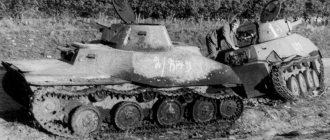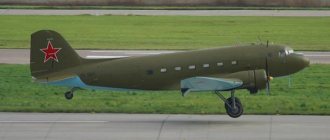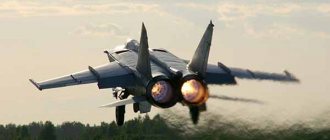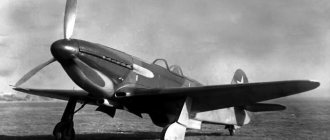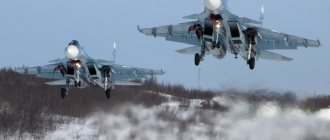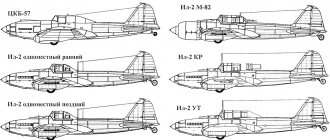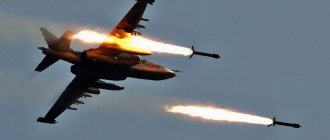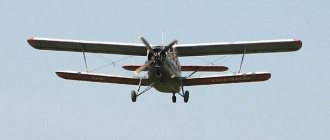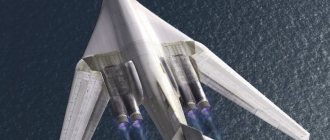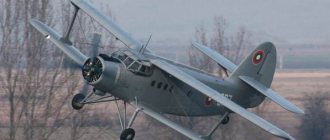Success with the Sh-1 amphibian, built in an apartment, inspired designer V.B. Shavrova. State tests conducted in Moscow confirmed the prospects of the amphibian design. It was decided to transfer the Sh-1 aircraft to the Leningrad organization Osoaviakhim for training and very popular propaganda flights in those years, and on its basis to develop an enlarged version of the aircraft with the domestic M-11 engine. All conditions were created for the successful completion of this task. An enlarged version of the amphibian, designated Sh-2, was no longer built in an apartment, but at an aviation facility in Leningrad.
Sh-2 amphibious aircraft - video
The Sh-1 layout showed its best side, and there was no point in changing the layout. The design of the Sh-2, like its first version, is wooden. The aircraft is designed as a sesquiplane with a three-seat cabin and a landing gear that is manually lifted from the cabin by a cable drive. In winter conditions, skis could be installed instead of wheels. The frame of the boat - made of pine and ash - was sheathed with plywood of different thicknesses (on the redan - 6 mm). On the outside, the entire boat, lower wings and floats were covered with dope cloth, which provided protection from water. The cantilever lower wing, located near the waterline and integral with the stability floats, was a single waterproof structure. In the event of an accident, they reliably kept the plane afloat.
The upper two-spar wing of the Sh-2 aircraft was braced; it could be folded back to save space in a hangar or on the deck of a ship. The cabin in front could accommodate two people, and behind it another one, or even two. Engine M-11 with a power of 100 hp. was located on the upper wing. The drag screw cooled the engine well even when moving at low speeds. In addition, it made it possible to shift the center of gravity of an empty aircraft forward relative to the wing tip. The first flight was carried out over land on November 11, 1930 by pilot B.V. Glagolev. Everything was completed successfully, and no adjustments were required. We decided to test the plane on the water. Worsening weather, strong winds, occasional snow, and most importantly a large wave were not conducive to the flight. But the aircraft’s builders, who were eager to hand over the aircraft for state testing as quickly as possible, did not wait for the weather to improve. On November 14, pilot Glagolev and Shavrov went on a flight. During landing, when hitting the waves, the redan, which was made at the insistence of the Air Force Scientific and Technical Committee attached with bolts, came off. The bow and central parts of the boat filled with water, but the amphibian remained afloat. It was held on the surface by the lower wings with their stability floats. The incident confirmed, on the one hand, the effectiveness of the design of the lower wing of the aircraft, and on the other, the irrationality of the removable step. During mass production, the redan was made non-removable.
After minor modifications to the prototype, the Sh-2 aircraft was put into mass production. During the period from 1932 to 1934, about 300 copies of various modifications were built. In the sanitary version, the seats of the pilot and doctor were covered with a transparent canopy. The rear wall of the cabin was cut through, and a stretcher was installed in the resulting volume. The Sh-2 is widely used in flight schools and flying clubs in the North, Far East and Arctic. Was on icebreakers for ice reconnaissance. The Sh-2 aircraft turned out to be one of the most durable in the world and was used for more than thirty years - until 1964. Since 1939, it began to be produced at repair bases in the Civil Air Fleet system, where several hundred aircraft were also produced.
Performing SHA-1 deprecation
All major web browser vendors such as Microsoft, Mozilla, Apple, Google, and other trusted parties began to require (and have been doing so for several years) that all clients, services, and products currently using SHA-1 migrate to SHA-2.
The time in which the transition must take place varied depending on the supplier. For example, many vendors only cared about TLS certificates (i.e. web servers). One of them, Microsoft Corporation, is now only concerned with having SHA-1 used on digital certificates from a "public" CA. However, expect that all vendors will soon be mandating the transition to SHA-2 for all applications and devices and all cryptographic hash functions, if they have not already done so. Currently, all browsers display an error message if a SHA-1 digital certificate is found on a website. Some of them allow you to ignore the error and, if desired, go to a site that is protected by SHA-1. Soon, all major browser vendors will probably prohibit visiting sites with SHA-1 protection. Unfortunately, moving from SHA-1 to SHA-2 is a one-way operation in most server cases. For example, once you change your server's certificate from SHA-1 to SHA-2, clients that do not understand SHA-2 certificates will likely receive warnings or errors, and the application may simply not work. Switching to SHA-2 is a risky move for applications and devices that do not support this hashing.
Performance characteristics of the Sh-2 aircraft
— Chief designer: V. B. Shavrov — First flight: November 11, 1930 — End of operation: 1964 — Units produced: 1200
The crew of the Sh-2 aircraft
— 2 people (pilot and mechanic) + 1 passenger
Dimensions of the Sh-2 aircraft
— Length: 8.2 m — Height: 3.5 m — Wing span: 13.0 m — Wing area: 24.7 m²
Sh-2 aircraft weight
— Empty weight: 660 kg — Normal takeoff weight: 937 kg
Sh-2 aircraft engine
— M-11 — Power: 100 hp.
Aircraft speed Sh-2
— Maximum speed: 139 km/h — Lift-off speed: 70 km/h — Landing speed: 65 km/h — Cruising speed: 80 km/h
Flight range of the Sh-2 aircraft
— 500 km
Service ceiling of the Sh-2 aircraft
— 3100 m
Central Air Force Museum
Su-27 aircraft.
photo. story. characteristics On July 31, 2022, as part of the celebration of the 105th anniversary of the creation of Navy aviation, a ceremonial transfer by representatives of 1-2-3 Production LLC took place at the Central Museum of the Air Force (a branch of the Central Museum of the Armed Forces of the Russian Federation) in Monino, Moscow Region. a unique aircraft - the Sh-2 multi-purpose flying boat
The ceremony of handing over the aircraft was attended by representatives of the administration of the Shchelkovo urban district of the Moscow region, veterans of the Air Force Academy. Yu. A. Gararina, representatives of military units of the naval aviation of the Navy and military transport aviation of the Aerospace Forces, as well as visitors to the museum.
Today, only two museums in the world have preserved examples of the Sh-2: the Russian State Museum of the Arctic and Antarctic in St. Petersburg (Russia) and the Historical Aviation Restoration Museum in Maryland Hayes (Missouri, USA).
- The acts of transfer of the Sh2 amphibian aircraft to the Museum were signed by: from the Museum, Chief Curator I.A.Boev, from the film company, producer P.K.Shakhlevich
Since 1932, the Sh-2 seaplane was actively used in the civil air fleet, as well as in polar aviation for ice reconnaissance in the interests of guiding convoys of ships along the Northern Sea Route. The Sh-2 seaplane was used on the famous icebreakers "Ermak", "Litke", "Krasin" and others. At the beginning of April 1934, after the death of the icebreaker ship "Chelyuskin" in the Arctic, the Sh-2 seaplane was on its deck , was saved. This allowed the pilot, the future Hero of the Soviet Union Mikhail Babushkin, to fly from O.Yu. Schmidt to Vankarem and help other pilots save the Chelyuskinites from the ice camp.
At the end of the 30s, the Red Army Air Force also showed interest in the flying boat. The amphibian entered service with naval aviation. In the Soviet-Finnish War and the Great Patriotic War, the Sh-2 seaplane was used in reconnaissance, operational communication with troops and removal of the wounded.
After the war, the Sh-2 seaplane operated until 1964. 32 years in operation is a rare survivability, which puts the Sh-2 seaplane on a par with such famous aircraft as An-2 and An-12 transport aircraft, multi-purpose Po-2 (U-2), passenger Tu-154 and Il-18 .
The unique aircraft took its rightful place in the exhibition of the Central Air Force Museum.
Participants in the ceremony of handing over a unique aircraft, the Sh-2 amphibious aircraft, to the Central Museum of the Air Force
Decommissioned and returned to service again
It all started with a report in one of the capital’s newspapers that during the war, the Irkutsk civil aviation repair plant N 403 not only repaired, but also built new amphibious aircraft for the front - Sh-2. They were produced jointly with the Leningrad aircraft repair workshops N 21 (ARM-21), evacuated to Siberia. However, this information could not be confirmed immediately. The book by Irkutsk historian I. Kuznetsov “Eastern Siberia during the Great Patriotic War” gave a list of all enterprises evacuated to Irkutsk. ARM-21 was not among them. Then I had to look for confirmation from living sources. Nikolai Fedorov, an employee of the Academy of Civil Aviation, and Leonid Kopach, a Leningrad guard who retired from Plant No. 403 and remained to live in Irkutsk, helped to make public these unknown facts regarding the contribution of the Irkutsk people to the victory.
The Sh-2 aircraft was created in 1928 by aircraft designer Vadim Shavrov. The amphibious aircraft was an amazing aircraft, designed for a pilot and two passengers, capable of taking off and landing both from land and from water. This aircraft was successfully used by fishermen, geologists, foresters and was indispensable in medical aviation. The amphibian found its use throughout the country. It was easy to operate, easily took off and rose from the airfield, and also easily landed on the ground or water surface. By 1939, the Sh-2s produced at the country's aircraft factories began to gradually fail, their service life had expired, and almost all of them were written off. However, the war with Finland, which took place in an area with many lakes and swamps, immediately revealed the urgent need for these amphibians. They allowed for operational communication with troops and were indispensable for transporting the wounded from difficult terrain. The GU Civil Air Fleet (Main Directorate of the Civil Air Fleet) ordered the “shavrushki” (as the pilots called the Sh-2) to be returned to service. For this purpose, decommissioned amphibians were sent to ARM-21 in Leningrad, where they underwent major repairs before being sent to the combat area. However, there were not enough repaired aircraft. Then ARM-21 offered to start producing new aircraft. The design team, headed by V. Rentel, coped with the task, and by the beginning of 1940 the first amphibious aircraft was produced. Moreover, significant changes appeared in the design of the newborn Sh-2, which improved its flight and technical characteristics.
Modifications and weapons
Since the release of the AR 2 bomber did not last long, the aircraft did not have time to acquire modifications. But the design solutions incorporated in the aircraft served as the basis for the creation of the SBB (High-Speed Short-Range Bomber) project. The only copy of such an aircraft was built and tested at the end of 1940 - beginning of 1941.
Further development of the AR 2 and SBB projects was hampered by the hasty deployment at the 22nd plant of the production of the more promising PE 2 dive bomber, which by March 1941 had completely ousted the AR 2 from production. The outbreak of war and the subsequent evacuation of the Arkhangelsky Design Bureau to Omsk put an end to the projects.
The armament design of the AR 2 serial bomber was a development of solutions tested on SB and MMN aircraft.
As a defensive weapon, the aircraft had three firing points equipped with 7.62 mm ShKAS machine guns:
- Bow ball launcher, from which the navigator fired. The machine gun had a conventional mechanical sight and 500 rounds of ammunition.
- TSS 1 rotating turret with a collimator sight and 1000 rounds of ammunition, located on the upper rear side of the fuselage. From above, the installation was closed with a sliding plexiglass cap, in which there was a cutout for the barrel of a machine gun.
- Retractable turret with 600 rounds to protect the lower hemisphere. Fire from both installations in the rear was conducted by one onboard gunner.
All three AR 2 points had good firing angles and left virtually no “dead” zones. The big disadvantage was the use of one shooter to service two installations. When two fighters attacked from different directions, the gunner was simply physically unable to repulse them simultaneously.
To improve combat qualities, a number of improvements were introduced in bomb weapons.
The AR 2 dive bomber had external and internal suspensions that allowed the use of up to four high-explosive bombs weighing 250 kilograms each. All outer holders have been recessed to improve aerodynamics.
German soldiers inspect the Soviet Ar-2 bomber shot down near Demyansk.
Subsequently, the number of bombs weighing 250 kg was increased to six (overload). Optionally, instead of them, three more powerful FAB 500 bombs could be suspended, weighing half a ton each. In this case, one bomb was placed inside the fuselage, and two - on external suspensions. Both types of bombs could be used for dive bombing.
When using the AR 2 aircraft for bombing in horizontal flight, there were three combinations of bomb suspension:
- 3 bombs weighing 500 kg,
- 6 bombs weighing 250 kg (two of them on the internal suspension),
- 12 FAB 100 bombs weighing 100 kg each (4 of them outside the fuselage).
In addition to high-explosive bombs, the AR 2 bomber could carry chemical weapons, consisting of two VAP pouring devices or two UKAP chemical aircraft devices. Both devices could be filled with any poisonous or incendiary substance and were mounted only on an external sling.
Notes
- S. Radimov.
Amphibious aircraft Sh-2 in the sky over Irkutsk // SM Number One: newspaper. - 2005. - No. 5 May. - Babushkin M. S.
Notes of pilot M. S. Babushkin.
1893-1938 (inaccessible link - history
). Glavsevmorput Publishing House (1941). Retrieved May 23, 2013. Archived December 13, 2011. - Backwoods Landing Strip - Finnish Air Force aircraft (inaccessible link - history
). Retrieved July 14, 2008. Archived November 14, 1999. - Sh-2 (“shavrushka”) amphibious aircraft - shipborne reconnaissance aircraft, messenger, messenger, ambulance, etc.
- Amphibious aircraft Sh-2 designed by V. B. Shavrov
- Petrov G. F.
Seaplanes and ekranoplanes of Russia. 1910 - 1999. - M.: Russian Aviation Joint Stock Company (RUSAVIA), 2000. - P. 222. - 248 p.
Modernity[edit | edit code]
Transport aircraft IL-476: history and performance characteristics
Surviving specimens are presented in museums:
- Russian State Museum of the Arctic and Antarctic in St. Petersburg
- Historical Aviation Restoration Museum in Maryland Hayes (Missouri, USA)
A flying copy of the Sh-2 on a scale of 0.75:1, first demonstrated on the SLA-89 in Riga, was built at the Youth Aviation Center in Urai. It was created by enthusiasts who had no previous experience in building aircraft. The lack of an M-11 engine forced them to take a 4-cylinder Prague engine with 75 hp. and reduce the size of the aircraft. It was flown by Yu.P. Sheffer, who gave an excellent assessment of the aircraft; it was awarded one of the main prizes of the SLA-89. Subsequently, these same enthusiasts built a full-scale copy of the Sh-2, which was demonstrated at the MAKS-95, MAKS-97 exhibitions, the Gelendzhik-96 Hydroaviation Show and other air shows.
Drawings and recommendations for modeling the Sh-2 were published in the magazine “Modelist-Constructor”. Kits for creating models were produced by the Ukrainian (1:72, plastic) and Orel publishing houses (1:33, paper).
In 1977, the USSR Post issued a postage stamp depicting the Sh-2 seaplane.
PKI transition models
The following are scenarios for implementing SHA-2 into PKI components (for these examples, a two-level PKI is used - autonomous root system, online certificate authorities), each of which can be either a new component or a migrated one:
Two PKI trees, one all SHA-1, the other all SHA-2.
The remaining scenarios assume one PKI tree:
- The entire PKI tree, from the root to the endpoints, is SHA-1.
- The entire PKI tree, from the root to the endpoints, is SHA-2.
- The root is SHA-1, the issuing CAs are SHA-2, and the endpoint certificates are SHA-2.
- The root is SHA-1, the issuing CAs are SHA-2, and the endpoint certificates are SHA-1.
- The root is SHA-1, the issuing CAs are SHA-2 and SHA-1, and the endpoint certificates are SHA-2 and SHA-1.
- The root is SHA-2, the issuing CAs are SHA-1, and the endpoint certificates are SHA-1.
- The root is SHA-2, the issuing CAs are SHA-2, and the endpoint certificates are SHA-1.
- The root is SHA-2, the issuing CAs are SHA-2 and SHA-1, and the endpoint certificates are SHA-2 and SHA-1.
It is also possible to have an issuing CA that switches between SHA-1 and SHA-2 as needed, but this is likely to cause confusion in PKI services (and is not particularly recommended). If possible, to ease the transition, you can run parallel PKIs, one with SHA-1, the other with SHA-2, and then migrate the devices used once testing allows.
Note: The root CA's own CA certificate does not need to be migrated to SHA-2, even if it still uses SHA-1. All legacy SHA-1 checkers take care of everything after the root CA's own certificate (and will, at least for the foreseeable future). However, it makes sense to move everything, including the root CA's own CA certificate, to SHA-2 so that you can say that the entire PKI is SHA-2 and avoid further SHA-1-related changes for the foreseeable future.
Public CAs have already migrated from SHA-1 to SHA-2 for any certificates with a lifetime expiring after January 1, 2022, so you should focus your efforts on servers and applications that have not yet migrated to SHA-2 public digital certificates. Once this issue is resolved, you can start looking at internal PKIs and trusted parties. The transition from SHA-1 to SHA-2 is not technically difficult, but it is a massive logistical change with many implications that requires extensive testing.
It's unlikely that most vendors will know the exact date of death of SHA-1 (i.e., the date when its use in an application or device will result in "fatal" errors), but it will likely happen sooner than you expect as more users switches to SHA-2. So you really should make the switch now.
Production[edit | edit code]
Serial production of the Sh-2 was organized at Taganrog Plant No. 31, the first aircraft was produced on April 1, 1932. For the needs of air ambulances, a sanitary version of the amphibian with a compartment for stretchers designed by F. F. Lipgart was designed (16 such aircraft were manufactured).
A total of 270 vehicles were produced in 1932-1934, after which their production ceased. The aircraft that were in service, having exhausted their service life, were gradually written off, and by the fall of 1939 there were practically none left in service.
The situation changed with the beginning of the Soviet-Finnish War, when it became clear that there was a need for a small seaplane for operational communications among the troops, transporting the wounded, etc. in swampy areas, a large number of rivers and lakes. In this regard, the Civil Air Fleet Main Directorate decided to return the decommissioned Sh-2s to service. The restoration and overhaul of these machines was carried out by the Leningrad aircraft repair workshops of the Civil Air Fleet (ARM-21). At the same time, it turned out that the simplicity and low cost of the aircraft’s design (it was cheaper to produce than even the U-2 (Po-2)) made it possible to resume their serial production. Under the leadership of V.F. Rentel, the project was modernized - new aircraft received an M-11D engine, improved engine mount shock absorbers, counter struts, etc. Before the start of the Great Patriotic War, 50 aircraft were assembled in the workshops.
During the evacuation of ARM-21 in August 1941 to Irkutsk, finished parts for 20 Sh-2 aircraft were also sent there; the first aircraft were produced there in 1942. A new production was also organized at the Civil Air Fleet Repair Plant No. 403, while a number of changes were made to the design, dictated by the difficulties of supply during the war. In total, from 1942 to 1945, 150 new Sh-2s were produced in Irkutsk and 286 were repaired.
After the war, the aircraft was produced in Irkutsk in large quantities in 1946-1947 and 1951-1952. The modified version included a new, more powerful version of the M-11 engine (M-11L, 115 hp and M-11K, 125 hp), a device for starting it from a compressed air cylinder, trimmers on the steering wheels heights and directions, closed cabin, etc.
There is no exact data on the number of Sh-2s produced over all years. It is known that more than 700 of them were built (according to some estimates - from 800 to 1200). The simplicity and high maintainability of the machine (sometimes they went through 4-5 major repairs) ensured this machine a long life.
Modernity
Surviving specimens are presented in museums:
- Russian State Museum of the Arctic and Antarctic in St. Petersburg
- Historical Aviation Restoration Museum in Maryland Hayes (Missouri, USA)
A flying copy of the Sh-2 on a scale of 0.75:1, first demonstrated on the SLA-89 in Riga, was built at the Youth Aviation Center in Urai. It was created by enthusiasts who had no previous experience in building aircraft. The lack of an M-11 engine forced them to take a 4-cylinder Prague engine with 75 hp. and reduce the size of the aircraft. It was flown by Yu.P. Sheffer, who gave an excellent assessment of the aircraft; it was awarded one of the main prizes of the SLA-89. Subsequently, these same enthusiasts built a full-scale copy of the Sh-2, which was demonstrated at the MAKS-95, MAKS-97 exhibitions, the Gelendzhik-96 Hydroaviation Show and other air shows.
Drawings and recommendations for modeling the Sh-2 were published in the magazine “Modelist-Constructor”. Kits for creating models were produced by the Ukrainian (1:72, plastic) and Orel publishing houses (1:33, paper).
In 1977, the USSR Post issued a postage stamp depicting the Sh-2 seaplane.
